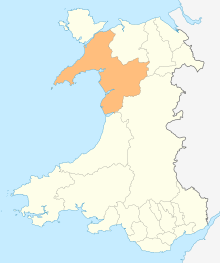Blaenau Ffestiniog
Blaenau Ffestiniog is a town in Gwynedd, Wales. Once a mining town in the historic county of Merionethshire, today the town relies heavily on tourists, who come for the Ffestiniog Railway and the Llechwedd Slate Caverns. Blaenau Ffestiniog was at one time the second largest town in North Wales, behind only Wrexham. After reaching 12,000 at the peak development of the slate industry, the population fell with the decline in the demand for its slate. The population of the community of Ffestiniog, including the nearby village Llan Ffestiniog, was 4,875 according to the 2011 census: the fourth most populous community in Gwynedd after Bangor, Caernarfon and Llandeiniolen. Llan Ffestiniog's population of 864 puts the population of Blaenau itself at around 4,000.
| Blaenau Ffestiniog | |
|---|---|
Church, Blaenau Ffestiniog | |
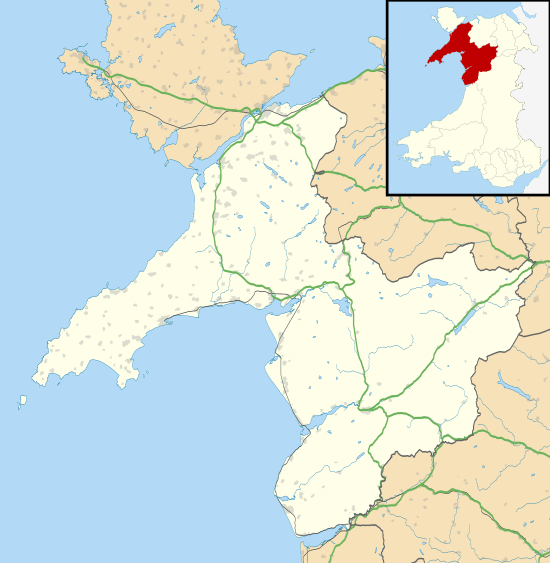 Blaenau Ffestiniog Location within Gwynedd | |
| Population | 4,000 (2011) |
| OS grid reference | SH705455 |
| Community | |
| Principal area | |
| Ceremonial county | |
| Country | Wales |
| Sovereign state | United Kingdom |
| Post town | BLAENAU FFESTINIOG |
| Postcode district | LL41 |
| Dialling code | 01766 |
| Police | North Wales |
| Fire | North Wales |
| Ambulance | Welsh |
| UK Parliament | |
| Senedd Cymru – Welsh Parliament |
|
History
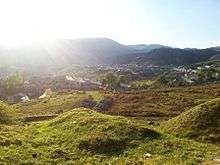
Farming (before 1750)
Before the slate industry developed, the area now known as Blaenau Ffestiniog was a farming region, with scattered farms working the uplands below the cliffs of Dolgaregddu and Nyth-y-Gigfran. A few of the historic farmhouses survive at Cwm Bowydd, Gelli, Pen y Bryn and Cefn Bychan. Much of the land was owned by large estates.[1]
Slate (1750–1850)
The town of Blaenau Ffestiniog was created to support workers in the local slate mines. At its peak, it was the largest town in Merioneth.[1] In the 1760s, men from the long-established Cilgwyn quarry near Nantlle started quarrying in Ceunant y Diphwys to the north-east of the present town. This valley had for a number of years been known for its slate beds and had been working on a very small scale. The exact location of this original quarry has been obliterated by subsequent mining activity, but it is likely that it was on or near the site of the Diphwys Casson Quarry. Led by Methusalem Jones, eight Cilgwyn men formed a partnership and took a lease on Gelli Farm, where they established their quarry. In 1800, William Turner and William Casson, quarry managers from the Lake District, bought the lease and significantly expanded production.[2]
In 1819, quarrying began on the slopes of Allt-fawr near Rhiwbryfdir Farm. This was on land owned by the Oakeley family from Tan y Bwlch. Within a decade, three separate slate quarries were operating on Allt-fawr and these eventually amalgamated to form Oakeley Quarry which would become the largest underground slate mine in the world.[3]
Quarrying expanded rapidly in the first half of the 19th century. Significant quarries opened at Llechwedd, Maenofferen and Votty & Bowydd, while Turner and Casson's Diphwys Casson flourished.[1] Further afield, Cwmorthin and Wrysgan quarries were established to the south of the town, while at the head of Cwm Penmachno to the north-east, a series of quarries started at Rhiwbach, Cwt y Bugail and Blaen y Cwm. To the south-east another cluster of quarries worked the slopes of Manod Mawr.
The workforce for these quarries was initially taken from nearby towns and villages such as Ffestiniog and Maentwrog. Before the arrival of railways in the district, travel to the quarries was difficult and workers' houses were built near the quarries. These typically grew up around existing farms and along the roads between them. An early settlement was at Rhiwbryfdir, serving the Oakeley and Llechwedd quarries. As early as 1801, new roads were being built specifically to serve the quarries. By 1851, there were 3,460 people living in the new town of Blaenau Ffestiniog.[1]
Urbanization (1851–1900)
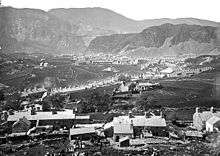
During the 1860s and 1870s the slate industry went through a boom. The quarries expanded rapidly, as did the nascent town of Blaenau Ffestiniog. The town gained its first church and first school, and saw considerable ribbon development along the roads.[1] By 1881, the town's population had soared to 11,274.[4] The boom in the slate industry was followed by a significant decline. The 1890s saw several quarries lose money for the first time, and several failed entirely, including Cwmorthin and Nyth-y-Gigfran.[5]
Blaenau Ffestiniog hosted the National Eisteddfod in 1898.
Slate decline (1901–1950)
Although the slate industry partly recovered from the recession of the 1890s, it never fully recovered. The First World War saw many quarrymen join the Armed Forces, and production fell. There was a short post-war boom, but the long-term trend was towards mass-produced tiles and cheaper slate from Spain. Oakeley Quarry took over Cwmorthin, Votty & Bowydd and Diphwys Casson, while Llechwedd acquired Maenofferen. Despite this consolidation, the industry continued to decline. The Second World War saw a further loss of available workers. In 1946, the Ffestiniog Railway closed.[5]
Since 1945
In August 1945 the secluded farmhouse of Bwlch Ocyn, at Manod, which belonged to Clough Williams-Ellis, became the home, for three years, of the writer Arthur Koestler and his wife Mamaine. During his time there, Koestler would become a close friend of his fellow writer George Orwell.[6]
.jpg)
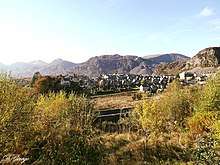
The slate quarries continued to decline steadily after 1950. The remaining quarries served by the Rhiwbach Tramway closed during the 1950s and 1960s. Oakeley closed in 1970, with the loss of many local jobs. It re-opened in 1974 on a much smaller scale and was worked until 2010.[7] Maenofferen and Llechwedd continued to operate, but Maenofferen finally closed in 1998.[8] Llechwedd is still a working quarry, working the David Jones part of Maenofferen (level two-and-a-half).
As the slate industry declined, the population of Blaenau Ffestiniog also fell, to 4,875 in 2011. At the same time the tourism industry has become the town's largest employer. The revived Ffestiniog Railway and the Llechwedd Slate Caverns are popular tourist attractions, as is the Antur Stiniog downhill mountain biking centre.[9] Recent attractions include the Zip World Titan zip-line site, which also now features the Bounce Below slate mine activity centre.
Pronunciation
The English pronunciation of Blaenau Ffestiniog suggested by the BBC Pronouncing Dictionary of British Names is /ˈblaɪnaɪ fɛsˈtɪnjɒɡ/,[10] but the first word is pronounced [ˈbləɨna] by locals.
Geography
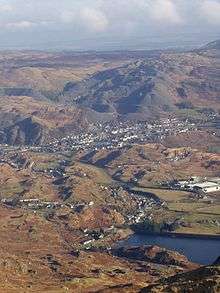
Blaenau Ffestiniog is made up of a number of distinct areas, several of which take their names from settlements that predate the town, including Rhiwbryfdir, Glanypwll and Cwmbowydd.. Other local villages, notably Tanygrisiau and Manod, are sometimes considered part of Blaenau Ffestiniog.
Located in the mountains of Snowdonia, the town's slate industry declined during the early 20th century. The town's economy is now largely dependent on tourism. Although the town is in the centre of the Snowdonia National Park, the boundaries of the Park exclude the town and its substantial slate waste heaps. Blaenau Ffestiniog is known as the town with one of the highest rainfall in Wales. The town has several reservoirs, one of which supplies the Ffestiniog Hydro Power Station with water. Stwlan Dam can be seen in between two of the main mountains in the area, Moelwyn Bach and Moelwyn Mawr. The mountains around Blaenau Ffestiniog form the watershed between the River Lledr flowing to the north (a tributary of the River Conwy) and the River Dwyryd flowing to the west.
Education
.jpg)
Ysgol y Moelwyn is the main secondary school in the area, covering Blaenau, Manod, Tanygrisiau, Llan Ffestiniog, Trawsfynydd, Gellilydan, Maentwrog and even stretching into the Vale of Ffestiniog and Dolwyddelan. It came third in Britain's best county school in 2006 and had 309 pupils on roll in 2016.[11] Some pupils travel to neighbouring towns.
There are five primary schools in the area.
Welsh language
Blaenau Ffestiniog is mainly Welsh-speaking. At the 2011 census, 78.6 per cent of residents over the age of three stated that they could speak Welsh, a slight fall from 80.9 per cent at the 2001 census.[12] The latest inspection reports of the town's two primary schools, Ysgol Maenofferen and Ysgol Y Manod, both from 2016, put the percentage of pupils speaking Welsh at home in each school at 87 and 85 per cent. At the town's secondary school, Ysgol y Moelwyn, 82 per cent of pupils came from such Welsh-speaking homes in 2014, making its Welsh-speaking intake the highest for secondary schools in the former county of Meirionnydd and the fourth highest for those in Gwynedd.
Transport
The main access route to Blaenau Ffestiniog is the A470 road running north to Llandudno and south to Dolgellau and beyond. The A496 runs south to the coastal resorts of Harlech and Barmouth and connects with the A487 towards Porthmadog and the Llŷn Peninsula. Immediately to the north of the town, the A470 climbs steeply to the Crimea Pass and meets the A5 at Betws-y-Coed, giving access to Llangollen, Wrexham and Shrewsbury in the east and Bangor and Holyhead in the west.
Bus services in the town are mainly provided by Arriva Buses Wales and Llew Jones, with routes available to Porthmadog, Dolgellau and to Llandudno via Betws-y-Coed and Llanrwst. Town circular services via Tanygrisiau are operated hourly on weekdays by John's Coaches.
Blaenau Ffestiniog railway station, on the site of the former Great Western station, is used by the Ffestiniog Railway and the Conwy Valley Line, their previous stations being no longer in use. The Conwy Valley line runs to the North Wales coast at Llandudno Junction with links to Chester, Holyhead, Manchester and the rest of the UK.
At various times the town has been the terminus for four independent railway lines, each with its own station or stations:
- The Ffestiniog Railway
- The Festiniog & Blaenau Railway
- The Conwy Valley line of the London & North Western Railway
- The Bala Ffestiniog Line of the Great Western Railway.
Tourism
Blaenau Ffestiniog has several tourist attractions, including the Ffestiniog Railway and the Llechwedd Slate Caverns, a former slate mine open to visitors. Llechwedd is often listed as one of Wales' top five visitor attractions.[13] Near Blaenau Ffestiniog there are miles of mountain landscape with derelict quarries, rivers, various lakes and walking routes.
Several new mountain biking trails have been created, some of them suitable for competition-level mountain biking. Visitors can hire bikes from the biking centre to explore trails of varying difficulty.
The town centre has several cafes and pubs. Its various features include child-friendly potholing, poetry walks, art centres, and views of the area.
Regeneration
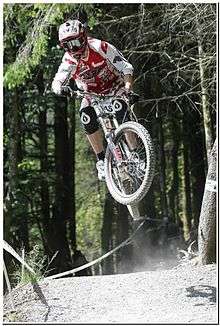
The town centre has recently been regenerated. With funding from various organisations, grants and the Welsh Government, £4.5 million will be spent on redevelopment. A new bus station has been built along with new viewing areas for the neighbouring mountain ranges. Several slate structures have been built with poetry engraved on them. The structures are about 40 feet tall and are intended to visually echo the towering slate hills and mountains. Poetry and local sayings have also been engraved on slate bands set into the pavements throughout the town centre.[14]
Various walkways have been installed, as well as a series of downhill mountain biking trails by Antur Stiniog.[15]
A kilometre-long zip-wire has been erected at Llechwedd Slate Caverns, which is popular with thrill-seekers.
If plans go ahead Blaenau Ffestiniog will have the UK's first vélo-rail, which is popular in France.[16]
Arts
Many artists come to Blaenau Ffestiniog for the landscape around it, perhaps inspired by the harsh landscape of the slate tips. They include Kyffin Williams and David Nash.
During World War II the National Gallery stored its treasures in one of the mines in the town to protect them from damage or destruction. The large steel gates are still standing and the system to preserve the paintings is still in the caverns.
Music
Blaenau Ffestiniog has a strong musical tradition from the quarrying boom days, with the Caban, male voice choirs and brass bands, to the Jazz/ Dance bands like "The New Majestics" and the popular rock bands of the 1980s and 1990s, such as Llwybr Llaethog and Anweledig, to more recent bands such as Gai Toms, Frizbee and Gwibdaith Hen Frân. The local alternative music training company Gwallgofiaid now has over 12 bands based at their Centre 'Cell' at the Old Police Station in Park Square. The Centre has 5 rehearsal rooms, a 24 track studio and Cwrt performance space.
Notable people
In chronological order:
- John Cowper Powys (1872–1963), novelist, lived in Blaenau Ffestiniog from May 1955 until his death.
- Margarette Golding (1881–1939), founder of International Inner Wheel, a women's voluntary service association, was born in Blaenau Ffestiniog on 20 November 1881.[17]
- Gwyn Thomas (1936–2016), Welsh poet, academic and National Poet for Wales in 2006–2008
- David Nash (born 1945), artist
- Dave Felgate (born 1960), footballer
- Gai Toms (born 1976), music artist
- Llwybr Llaethog (founded 1985), musical group
- Anweledig (founded 1992), musical group
Twinning
See also
- Llan Ffestiniog
- Tanygrisiau
- Llechwedd quarry
- Oakeley Quarry
- Maenofferen Quarry
- Ffestiniog Memorial Hospital
References
- "Blaenau Ffestiniog: Understanding Urban Character" (PDF). Cadw.
- Gwynfor Pierce Jones and Dafydd Walter Dafis (2002). "Water Power in the Slate Mines of East Ffestiniog" (PDF). Archived from the original (PDF) on 19 May 2012. Retrieved 10 June 2019. Cite journal requires
|journal=(help) - Jones, R. Merfyn (1981). The North Wales Quarrymen, 1874–1922 (Studies in Welsh history; 4). University of Wales Press. ISBN 0-7083-0776-0.
- Davies, John (1993). A History of Wales.
- Boyd, James I.C. (1975) [1959]. The Festiniog Railway 1800 - 1974; Vol. 2 - Locomotives and Rolling Stock; Quarries and Branches: Rebirth 1954-74. The British Narrow Gauge Railway. Blandford: The Oakwood Press. ISBN 978-0-85361-168-4. OCLC 874117875. B1B.
- "The Untouched Legacy of Arthur Koestler and George Orwell". 24 February 2016. Retrieved 2 September 2017.
- BBC Wales News
- Sallery, Dave. "Maenofferen slate quarry in 1975".
- "Blaenau Ffestiniog mountain bike centre given go-ahead". BBC News. 22 March 2011.
- G. M. Miller, ed., BBC Pronouncing Dictionary of British Names, Oxford University Press, 1971. ISBN 0-19-431125-2
- "Ysgol Y Moelwyn". mylocalschool.wales.gov.uk. Retrieved 6 December 2016.
- "Census results by community". Retrieved 9 September 2013.
- icnetwork.co.uk Archived 18 August 2006 at the Wayback Machine
- blaenauffestiniog.org
- Antur Stiniog website accessdate: 13 November 2013
- "Linkliste Railbike". 9 January 2008. Retrieved 10 June 2013. lists 14 vélo-rails in France, totalling 146 km.
- "Inside the Inner Wheel". International Inner Wheel. Archived from the original on 24 July 2017. Retrieved 24 May 2017.
- "Archived copy". Archived from the original on 18 July 2015. Retrieved 7 June 2015.CS1 maint: archived copy as title (link) |Patagonian dignitaries to visit for twinning.
External links
| Wikimedia Commons has media related to Blaenau Ffestiniog. |
| Wikivoyage has a travel guide for Blaenau Ffestiniog. |
